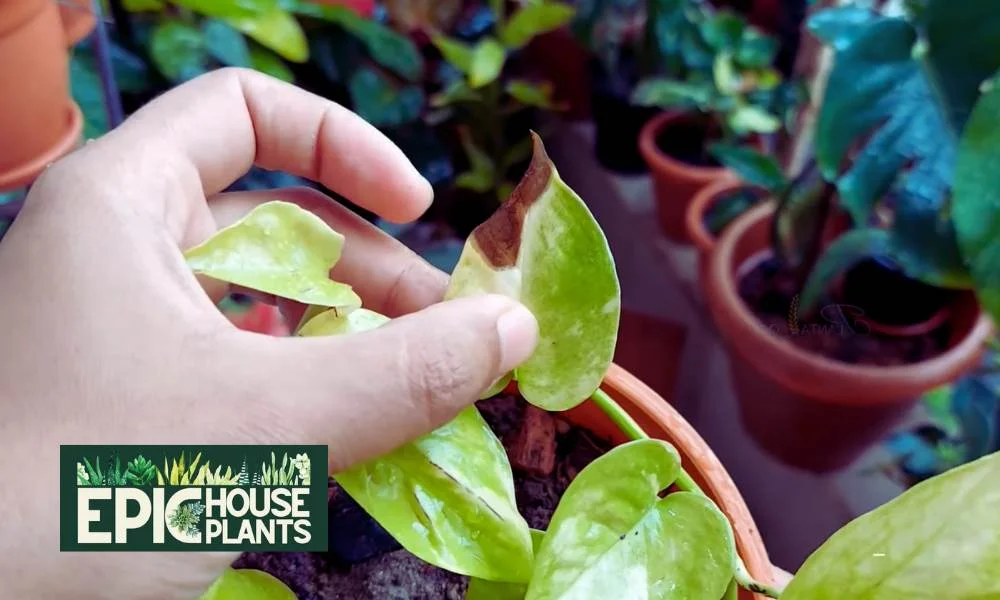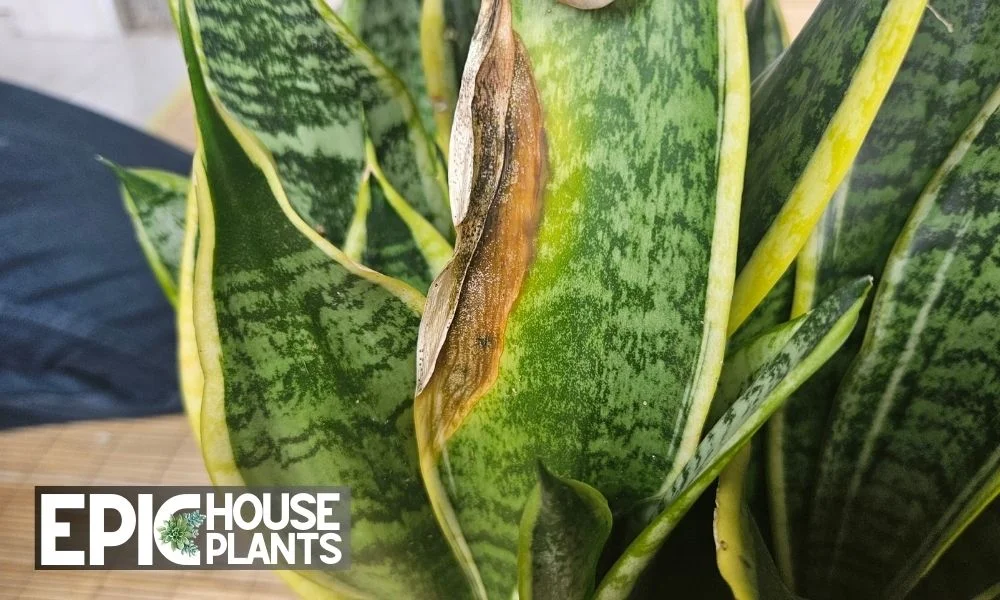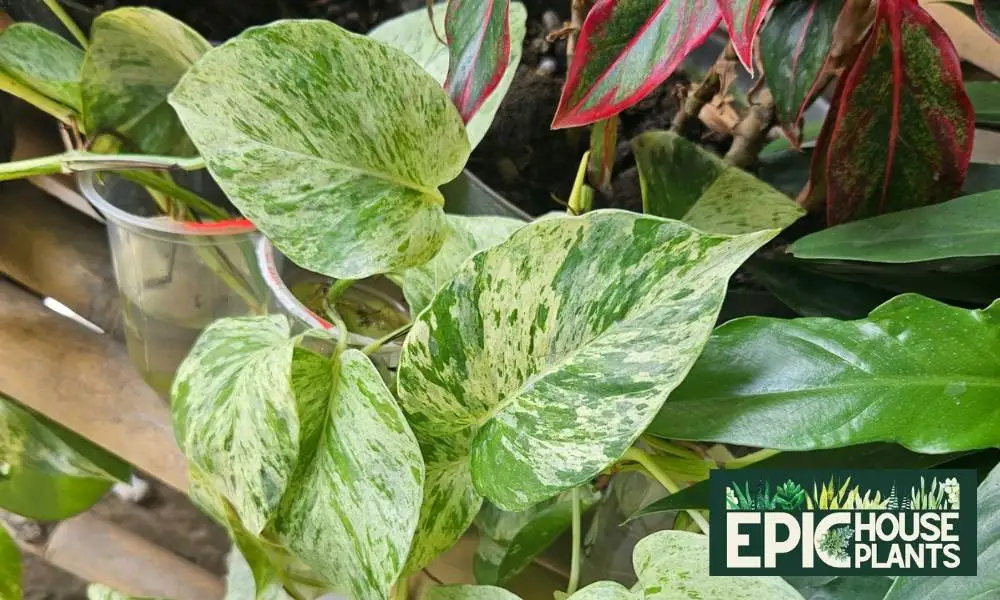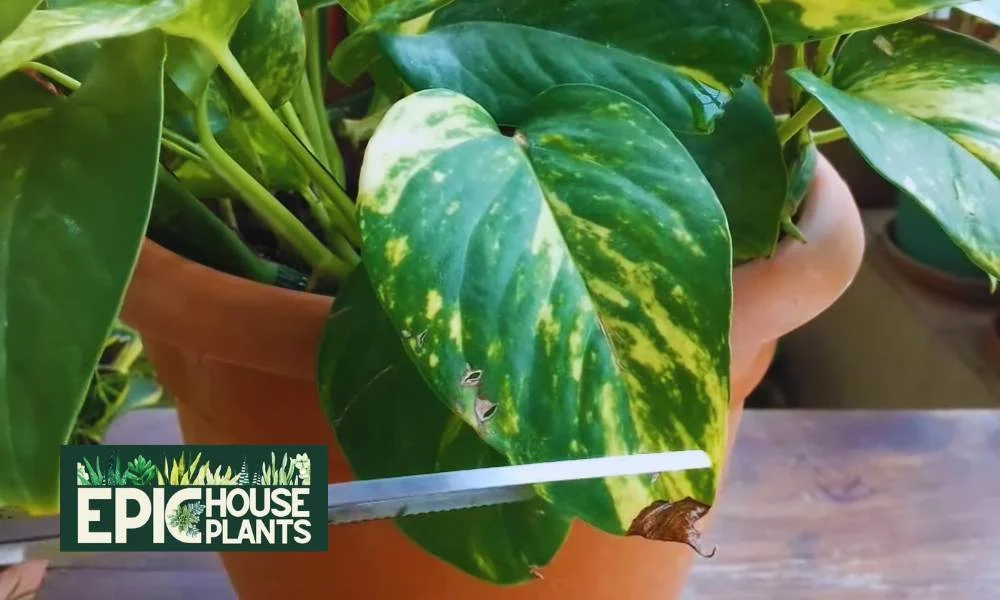Those lush, trailing vines of your beloved pothos suddenly sporting crispy brown edges? Don’t panic! While it may seem like a death sentence, brown leaves are simply your plant’s way of communicating its distress.
But fear not, plant detective, for by deciphering the clues, you can revive your pothos and restore its vibrant greenery.
How to Identify Photos Leaves Turning Brown

Identifying brown Pothos leaves and distinguishing them from healthy ones involves observing several key aspects of the leaves’ appearance and condition. Here’s how you can identify brown (unhealthy) Pothos leaves compared to healthy ones:
Characteristics of Healthy Pothos Leaves:
- Color: Healthy Pothos leaves are typically a vibrant green. Some varieties may have variegation, with patterns of yellow, white, or light green, but the colors are bright and vivid.
- Texture: The leaves should feel firm and pliable, not limp or overly rigid.
- Shape: They maintain their natural, heart-shaped form without any significant curling or distortion.
- Surface: The surface of healthy leaves is smooth and glossy, without any bumps, spots, or sticky residues.
- Edges: The edges of the leaves are even and intact, without browning or crisping.
Characteristics of Brown (Unhealthy) Pothos Leaves:
- Color Changes: Brown leaves often start with yellowing or develop brown spots or edges. The brown color can indicate various issues, including overwatering, underwatering, nutrient deficiencies, or burn from direct sunlight.
- Texture Changes: If the leaves feel mushy or excessively soft, it could be a sign of overwatering and root rot. Crispy, dry leaves usually indicate underwatering or heat/light stress.
- Wilting or Drooping: Unhealthy leaves may wilt or droop, indicating a problem with water uptake or overall plant health.
- Spots or Marks: Brown leaves can have spots or marks, which could be a sign of pests, disease, or physical damage.
- Curling: Leaves that curl inward or appear deformed may be reacting to environmental stress, like lack of water or excessive heat.
General Tips for Assessment:
- Overall Plant Health: Look at the plant as a whole. If most leaves are brown, it’s a sign of a more severe or systemic issue. If it’s just a few leaves, the problem might be localized or less serious.
- Pattern of Browning: Notice if the browning is occurring more at the tips, edges, or centers of the leaves, as this can indicate different issues (e.g., tips browning could be due to over-fertilization).
- Environmental Factors: Consider the plant’s environment – lighting, temperature, humidity, and watering routine – as these can offer clues to the cause of browning.
By carefully observing these aspects, you can identify brown, unhealthy Pothos leaves and take appropriate action to address the underlying issues. Remember, early detection and intervention are key to restoring and maintaining the health of your Pothos plant.
Summary Table
Here is the table provides a structured overview of the main categories of problems that can affect Pothos plants, their causes, and the recommended solutions and preventive measures.
| Main Reason | Causes | Solving and Prevention |
|---|---|---|
| Watering Issues | – Overwatering – Underwatering – Irregular Watering – Quality of Water | – Establish a Consistent Watering Routine – Monitor Environmental Conditions – Use Appropriate Water – Regular Health Checks |
| Light and Temperature Stress | – Light Stress – Temperature Stress – Humidity Stress | – Optimize Light Exposure – Maintain Ideal Temperature – Regulate Humidity – Gradual Adjustment to Changes |
| Nutritional Deficiencies and Fertilizer Use | – Nutritional Deficiencies – Fertilizer Burn – Soil pH Imbalance | – Balanced Fertilization – Correcting Deficiencies – Managing Soil pH – Observing Plant Response – Consistent Care |
| Pests and Diseases | – Spider Mites – Mealybugs – Scale Insects – Root Rot – Fungal Leaf Spot – Bacterial Infections | – Regular Inspection – Isolation – Treatment for Pests – Treatment for Diseases – Preventive Measures |

Also Read
For more tips on tackling brown tips in snake plants, visit our linked article for effective solutions.
The Reason Why Pothos Leaves Turning Brown
Let’s talk about the four common reasons why Pothos leaves might turn brown and how you can be the best plant parent ever!
Section 1: Watering Issues
Watering issues are one of the primary reasons Pothos leaves turn brown, and this can occur due to both overwatering and underwatering. Here’s why each of these situations can cause browning:
1. Overwatering
Pothos plants are quite sensitive to excessive moisture around their roots. When overwatered, the soil becomes waterlogged, depriving the roots of the oxygen they need to function properly. This oxygen deprivation leads to a condition known as root rot, where the roots start to decay.
Decaying roots become ineffective at transporting water and nutrients to the rest of the plant. As a result, leaves start to turn yellow and then brown, often becoming soft and mushy. Overwatering also creates an environment conducive to fungal and bacterial growth, which can further damage the plant.
2. Underwatering
On the other end of the spectrum, underwatering can also cause Pothos leaves to turn brown. When a Pothos doesn’t receive enough water, its soil dries out, and the roots cannot absorb the necessary moisture and nutrients.
The lack of water leads to dehydration in the plant. In response to this stress, the plant conserves water by reducing the amount sent to the leaves, leading to drying and browning, especially at the leaf edges and tips. These leaves often feel dry and crispy.
3. Irregular Watering
Fluctuations between overwatering and underwatering can also stress the plant, leading to browning leaves. Consistency in watering helps maintain a balance that is conducive to the plant’s health.
4. Quality of Water
The quality of water used for watering can also contribute to issues. Tap water, especially if it is hard or contains chemicals like fluoride or chlorine, can accumulate in the soil and potentially harm the roots or leaves of the Pothos, leading to browning.
Solving Watering Issues
1. Assess the Watering Schedule
Check the soil moisture before watering. The top inch of soil should be dry to the touch. Adjust your watering schedule accordingly. Stick your finger into the soil. If it feels dry up to your first knuckle, it’s watering time!
In winter, reduce watering frequency as the plant’s growth slows down.
2. Improve Drainage
Ensure that the pot has adequate drainage holes. If not, consider repotting your Pothos into a pot that allows excess water to escape.
Use a well-draining potting mix. A mix of peat, perlite, and vermiculite can provide good drainage and aeration.
3. Address Overwatering
If you suspect overwatering and root rot, remove the plant from its pot and inspect the roots. Healthy roots should be white and firm. Trim off any brown or mushy roots with sterile scissors.
Let the root system dry out for a bit before repotting in fresh, well-draining soil.
Revive Underwatered Pothos
For an underwatered plant, water it thoroughly. Allow the water to run through the drainage holes, then repeat after a few minutes.
If the soil is extremely dry and repels water, soak the pot in a tub of water for about an hour, allowing the soil to absorb moisture from the bottom up.
Section 2: Light and Temperature Stress

Light and temperature stress are significant factors that can cause Pothos leaves to turn brown, and understanding how they affect the plant is key to maintaining its health.
1. Light Stress
Too Much Direct Sunlight: Pothos plants prefer bright, indirect light. When exposed to direct sunlight for prolonged periods, their leaves can suffer from scorching. This exposure causes the leaves to turn yellow initially, then brown, and they may become crispy and brittle. The damage is usually most apparent on the parts of the leaf that receive the most sunlight.
Insufficient Light: While Pothos can tolerate low light conditions, prolonged lack of adequate light can lead to poor plant health. In low light, the plant may become leggy (stretched out) as it tries to reach for a light source, and the leaves can turn yellow or brown due to the reduced ability to photosynthesize effectively. Insufficient light weakens the plant overall, making it more susceptible to other stressors.
2. Temperature Stress
Too Cold or Hot: Pothos plants thrive in a temperature range of about 65-85°F (18-29°C). Temperatures outside this range, especially cold drafts or extreme heat, can stress the plant. Cold stress can cause the leaves to turn brown and wilt, while extreme heat, particularly when combined with low humidity, can lead to dried out and brown leaves.
Sudden Temperature Fluctuations: Pothos plants prefer a stable environment. Rapid changes in temperature, such as moving a plant from a very warm to a very cool room, can shock the plant, leading to browning leaves.
3. Humidity Stress
Pothos plants enjoy a moderate to high humidity level. Low humidity environments can lead to moisture loss from the leaves, causing them to turn brown, especially around the edges and tips.
Preventing Light and Temperature Stress
1. Optimize Light Exposure
- Place your Pothos in a location where it receives bright, indirect sunlight. Near a north or east-facing window is often ideal.
- If the only available light is direct sunlight, use sheer curtains or blinds to diffuse the light.
- Rotate the plant periodically to ensure even light distribution.
2. Maintain Ideal Temperature
- Keep your Pothos in a room where the temperature is within the ideal range of 65-85°F (18-29°C) and avoid placing it near drafts, air conditioning vents, or heating sources.
- Be cautious of placing your Pothos near windows that might become very cold in the winter or overly hot in the summer.
3. Regulate Humidity
- Increase humidity around the plant if you live in a dry area. This can be done by placing a humidifier nearby, grouping plants together, or placing the pot on a tray of water and pebbles (ensuring the pot is not sitting directly in water).
- Mist the leaves regularly, but be cautious not to overdo it as excessive moisture on leaves can encourage fungal diseases.
4. Gradual Adjustment to Changes
- When moving the plant to a different location, do it gradually to allow it to acclimate to the new environment, especially if there’s a significant change in light or temperature.
By carefully managing the light exposure, temperature, and humidity levels around your Pothos, you can significantly reduce the risk of stress that leads to browning leaves. Regular observation and slight adjustments as per the plant’s response are crucial for maintaining its health and vibrancy.

Also Read
Discover 13 Variegated Pothos types and their unique characteristics. Dive deeper into this captivating plant family to learn more about their beauty and care requirements.
Section 3: Nutritional Deficiencies and Fertilizer Use
Nutritional deficiencies and improper fertilizer use can lead to browning leaves in Pothos plants due to the following reasons:
1. Nutritional Deficiencies
- Essential Nutrients: Plants require a variety of nutrients for healthy growth, including nitrogen, phosphorus, potassium, and various micronutrients. A deficiency in any of these can lead to poor plant health and cause leaf discoloration.
- Nitrogen Deficiency: Nitrogen is crucial for leaf growth and development. A lack of nitrogen often results in yellowing leaves that may eventually turn brown, especially older leaves.
- Potassium Deficiency: Potassium is vital for various plant functions, including water regulation. Insufficient potassium can cause leaf edges or tips to turn brown and dry.
- Micronutrient Deficiencies: Elements like iron, magnesium, and calcium are needed in smaller amounts but are still essential. For example, magnesium deficiency can cause interveinal chlorosis (yellowing between leaf veins) and eventual browning.
2. Fertilizer Burn
- Excess Fertilizer: Over-fertilizing can lead to a buildup of salts in the soil, which can ‘burn’ the roots, impairing their ability to absorb water and nutrients. This stress often manifests as brown, crispy edges on leaves.
- Chemical Damage: Some fertilizers, particularly those high in chemicals, can directly damage the plant tissues if applied excessively or without proper dilution.
3. Soil pH Imbalance
- Nutrient Uptake Affected: The pH level of the soil can affect the plant’s ability to absorb nutrients. Pothos prefer a slightly acidic to neutral pH. An overly acidic or alkaline soil can lead to nutrient lockout, where the plant cannot access certain nutrients, leading to deficiencies.
Prevention and Correction of Nutritional Issues
1. Balanced Fertilization
- Use a balanced, water-soluble fertilizer formulated for houseplants. Fertilize your Pothos every 4-6 weeks during the growing season (spring and summer) and reduce or stop fertilizing in the fall and winter when the plant’s growth naturally slows.
- Always follow the recommended dilution rates on the fertilizer package to avoid over-concentration, which can lead to fertilizer burn.
2. Correcting Deficiencies
- If you suspect a specific nutrient deficiency, you can use a fertilizer that targets that particular nutrient. For example, a magnesium-rich fertilizer can be used to correct a magnesium deficiency.
- Regularly replacing or refreshing the soil can help maintain nutrient levels. Using a high-quality potting mix that includes a blend of nutrients is beneficial.
3. Managing Soil pH
- Test the soil pH if you suspect a pH imbalance. You can use a soil pH testing kit available at garden centers.
- To adjust an overly acidic soil, you can add lime. For overly alkaline soil, adding sulfur or using an acidifying fertilizer can help.
4. Observing Plant Response
- Regularly observe your plant’s reaction to fertilizing. Signs like sudden leaf discoloration or browning after fertilizing can indicate that the fertilizer strength is too high or the frequency is too much.
- If you notice signs of over-fertilization, such as salt buildup on the soil surface or pot edges, flush the soil with water to remove excess salts.
5. Consistent Care
- Along with proper fertilization, ensure that your Pothos is receiving adequate light, water, and humidity, as a balanced approach to care is crucial for overall plant health.
By understanding the balance of nutrients required by your Pothos and being mindful of how you apply fertilizer, you can prevent nutritional deficiencies and fertilizer-related issues that lead to browning leaves. Regular observation and adjustments based on the plant’s response are key to maintaining a healthy and vibrant Pothos.
Section 4: Pests and Diseases

Pests and diseases are significant factors that can cause Pothos leaves to turn brown. Each type of pest and disease affects the plant in different ways:
1. Pests
- Spider Mites: These tiny pests are often too small to see with the naked eye but can cause significant damage. They feed on the sap of the leaves, leading to yellowing and browning, and can cause fine webbing on the plant.
- Mealybugs: These are small, white, cottony pests that suck the sap from the leaves and stems. Their feeding not only weakens the plant but also leaves behind a sticky residue called honeydew, which can lead to sooty mold. Infested leaves often turn yellow and may brown.
- Scale Insects: These pests attach themselves to the leaves and stems, feeding on the plant’s sap. This feeding can cause yellowing of leaves, followed by browning and leaf drop.
2. Diseases
- Root Rot: Often a result of overwatering, root rot is a fungal or bacterial infection that affects the roots. It prevents the plant from absorbing water and nutrients effectively, leading to yellowing and browning of the leaves.
- Fungal Leaf Spot: Caused by various fungi, these diseases create brown or black spots on the leaves, which can spread and eventually kill the leaf. High humidity and poor air circulation often exacerbate this issue.
- Bacterial Infections: Bacterial infections can cause various symptoms, including leaf spots that start as water-soaked areas and then turn brown or black.
Prevention and Treatment of Pests and Diseases
1. Regular Inspection
- Regularly check your Pothos for signs of pests and diseases, especially under the leaves and along the stems.
2. Isolation
- If you detect pests or disease, isolate the affected plant from your other houseplants to prevent spread.
3. Treatment for Pests
- For mild infestations, wipe the leaves with a soft cloth dipped in soapy water. Be sure to reach the undersides of the leaves where pests often hide.
- For more severe infestations, use insecticidal soap or neem oil, applying it according to the product instructions.
4. Treatment for Diseases
- If root rot is suspected, remove the plant from its pot, trim away any brown or mushy roots, and repot in fresh, well-draining soil.
- For fungal leaf spots, remove affected leaves and apply a fungicide. Ensure the plant is in a well-ventilated area and avoid wetting the leaves when watering.
5. Preventive Measures
- Ensure good air circulation around your Pothos to prevent fungal diseases.
- Avoid overwatering and ensure proper drainage to prevent root rot.
- Keep the leaves clean to reduce the attraction of pests.
By taking these preventive and reactive measures, you can greatly reduce the risk of pest infestations and diseases in your Pothos. Regular care and vigilance are key to maintaining the health and beauty of your plant.
Remember: Early detection is key! Regularly check your pothos for signs of browning and act quickly to identify the cause. With a little TLC and detective work, you can solve the mystery of the browning leaves and restore your pothos to its glorious, green self.
What Should I Do When Pothos Leaves Turn Brown?
When dealing with brown leaves on a Pothos plant, it’s generally advisable to cut them off. Here are the reasons why and some guidelines on how to do it:
Reasons to Cut Off Brown Leaves
- Energy Conservation: The plant expends energy trying to repair damaged leaves. By removing brown leaves, you redirect this energy towards growing new, healthy foliage.
- Aesthetics: Brown leaves can be unsightly. Removing them improves the overall appearance of your plant.
- Disease Prevention: In some cases, brown leaves can be a sign of disease. Removing them can prevent potential spread to healthy parts of the plant.
- Improved Growth: Pruning encourages new growth, helping your Pothos become fuller and more vibrant.
How to Cut Brown Leaves

- Use Clean Tools: Always use clean, sharp scissors or pruning shears to prevent the spread of disease. Disinfect your tools before and after use, ideally with rubbing alcohol.
- Cut at the Base: Cut the brown leaves at the base of the stem, near the soil line or main stem. Avoid leaving stubs as they can rot and cause further problems.
- Partial Browning: If only a part of the leaf is brown, you can choose to trim off just the brown part to retain as much green, healthy tissue as possible. Make your cut in a shape that follows the natural contour of the leaf to keep it looking natural.
- Disposal: Dispose of the brown leaves properly. Do not leave them in the pot or on the soil, as they can harbor pests or disease.
- Monitor the Plant: After pruning, keep an eye on your Pothos to ensure it’s responding well and that no new browning occurs.
Additional Consideration
- Underlying Causes: While trimming brown leaves is helpful, it’s equally important to address the underlying cause of the browning, whether it’s due to watering issues, light stress, nutrient problems, or disease.
By trimming off the brown leaves and addressing the root cause of the issue, you can help your Pothos recover and thrive. Remember that plant care is an ongoing process, and regular observation and adjustment are key to maintaining healthy plants.
Conclusion
The browning of Pothos leaves is a common issue that can arise from various factors, including improper watering, light and temperature stress, nutritional imbalances, and pest or disease infestations. Understanding these factors is crucial in diagnosing and addressing the problem effectively.
Regular care and attention are key to maintaining a healthy Pothos. By monitoring watering practices, ensuring adequate light and stable temperatures, providing balanced nutrition, and keeping an eye out for pests and diseases, you can keep your Pothos thriving and preserve its natural beauty.
Remember, a healthy Pothos is not just a beautiful addition to your space but also a testament to your nurturing care.
Author

Pudji Haryanto
Pudji Haryanto is a writer and urban farmer with a passion for cultivating plants. He has over 15 years of experience in agriculture and currently manages a 65,000 square foot rice-field and yard filled with various plants, including vegetables, spices, flowers, and garden plants.

Content for your website http://fertus.shop/info/